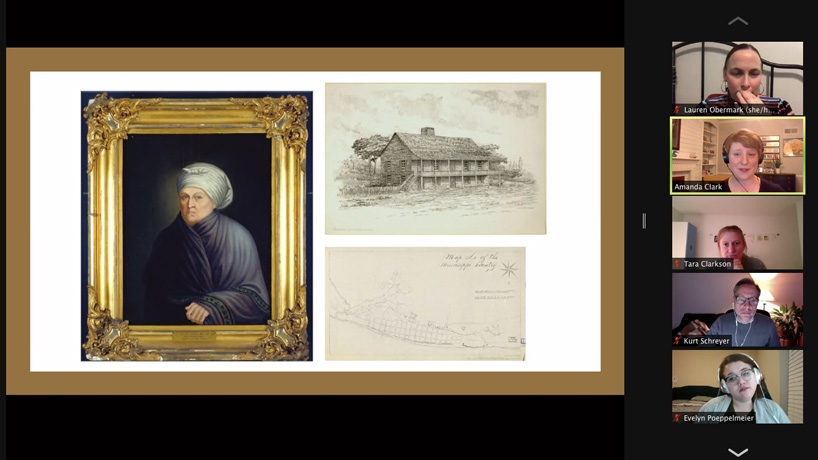
The Missouri Historical Society’s Amanda Clark (at right, second from the top) shares details of the life of Marie-Thérèse Bourgeois Chouteau during a Women’s History Month virtual event title “Lives on the Edge: St. Louis Colonial Women.” (Screenshots)
A group of French merchants came up the Mississippi River in 1763, looking to establish a trading post, and found what seemed like an ideal spot atop a 30-foot bluff overlooking the west bank, 18 miles south of the confluence with the Missouri River.
That was where they established St. Louis.
Women were not among the traveling party with Pierre Laclède and René Auguste Chouteau when they are said to have founded the village on Feb. 14, 1764 – on land that at that time had been ceded to Spain. But women would quickly assume notable roles as the village grew and a melting pot of people of many different backgrounds –Creole French, Canadian French, enslaved Africans, enslaved Native Americans and free Native Americans – just across the river from English-controlled territory.
A Women’s History Month virtual presentation titled “Lives on the Edge: St. Louis Colonial Women,” offered members of the University of Missouri–St. Louis community a chance to learn about some of that early history. The event, sponsored by the Black Futurity Group, the English and History departments and the Gender Studies Program, drew an audience of a few dozen people last Wednesday night on a Zoom conference.
Amanda Clark served as the guide for the evening. She is the former owner and operator of the history and architecture tour company Renegade Tours STL who since January 2020 has served as the community tours manager for the Missouri Historical Society. She is responsible for creating, organizing and managing See STL tours, a series of offbeat walking and bus tours that help connect participants to the region’s past, present and future.
Clark highlighted the stories of several prominent women from that period.
Maybe the most colorful character was Marie-Thérèse Bourgeois Chouteau, often called the mother of St. Louis, who was abandoned by her husband René Auguste Chouteau after giving birth to their son, René Auguste Chouteau Jr., in New Orleans in 1749.
As Clark explained, Marie Chouteau claimed to be widow, a position that allowed her greater social status and financial agency in French society at the time. She later began a relationship with Laclède that brought four additional children, though they never married.
She followed Laclède to St. Louis after he and her eldest son established their trading post.
“Once she settles with Pierre in St. Louis, she starts getting her own property,” Clark said. “She has a really high social status because she’s familiarly connected to Laclède, although still being called a widow.
“In 1767, just three years after they founded the village, René comes back and he’s like, ‘Hey, this is my wife, and this is all her property, and it’s mine.’ But her status is high enough that she’s able to convince the Spanish lieutenant governor that she’s effectually an independent widow, and he agrees to it. So even though her husband’s standing right there, she’s his widow, and he has to go back to France empty-pocketed.”
Clark also talked about Ester, a former enslaved woman given her freedom from prominent fur trader Jacques Clamorgan.
“Esther is considered to be the most successful of the women of color who own property,” Clark said. “She was born enslaved. She was purchased to settle a debt by Jacques Clamorgan, and he is a figure that deserves his own presentation, probably his own movie. He’s a big, big figure in St. Louis history. She becomes his mistress and a business partner of sorts. He’s a huge personality, and it turns out she’s also a huge personality. The two of them meet and, and he respects her and puts her in complete control of his home and business matters when he’s not in St. Louis.”
As Clark explained, Jacques Clamorgan, looking to protect some of his real estate assets, gives Ester her freedom in 1793 and shifts some of the real estate into her name, including an entire city block that today is part of Laclede’s Landing.
Ester left him after he engaged in a series of public affairs and took all her deeds with her, and the Spanish government upheld her property rights.
Clark also shared the story of the Scypion sisters, African-Natchez women who successfully won their freedom in court – establishing an example that Harriet and Dred Scott would later follow.
“There are so many women I could highlight on this,” Clark said. “But these are just a few examples of their lives and how they changed. The changing core of all of it – the changing of inheritance and property ownership – is what has the most profound effects on women.”














